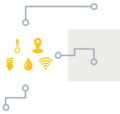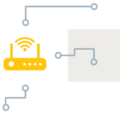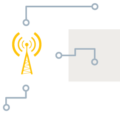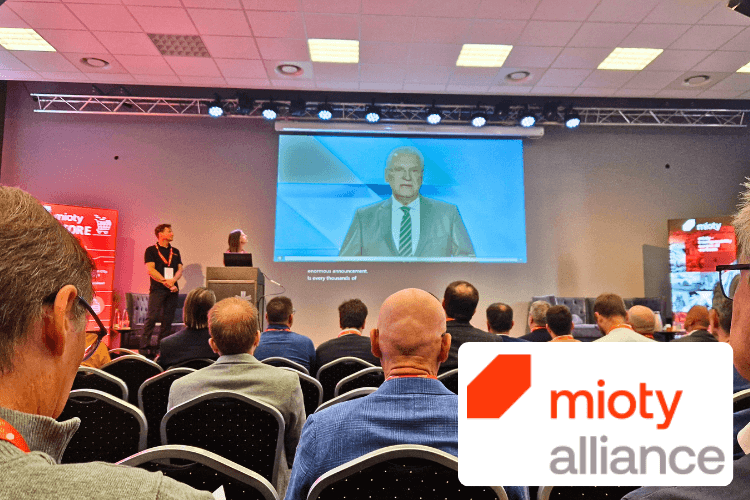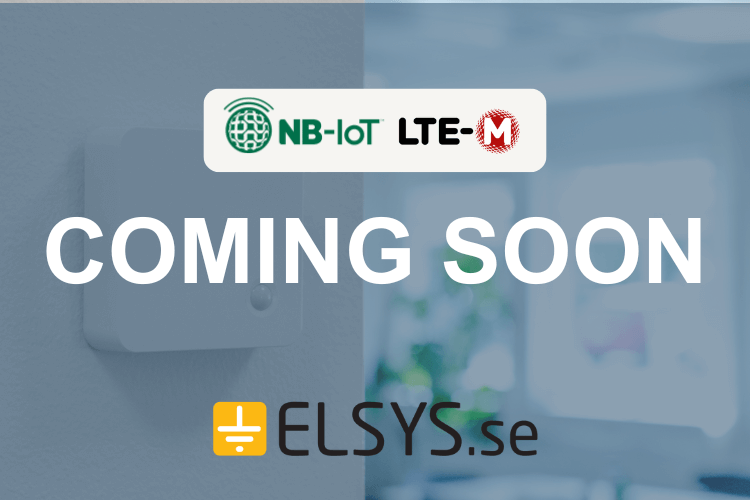Alles was Sie zu LoRa® und LoRaWAN® wissen müssen

LoRa & LoRaWAN – perfekt für IoT-Sensor-Netzwerke
LoRaWAN steht für Long Range Wide Area Network und ist ein Low-Power-Wireless-Netzprotokoll. Es ermöglicht ein energieeffizientes Senden von Daten über lange Strecken. Der verwendete Funkstandard LoRa wurde speziell für das Internet of Things (IoT) und Industrial Internet of Things (IIoT) entwickelt. Mit LoRaWAN können mehrere hundert Sensoren innerhalb eines Netzwerkes verwaltet und deren Sensordaten verarbeitet werden. Je nach Anwendung können Sensoren bis zu 10 Jahren ohne Batteriewechsel betrieben werden, was den Wartungsaufwand erheblich verringert. Bei LoRa und LoRaWAN werden die Datenpakete vom Sender bis zum Application Server grundsätzlich mit AES verschlüsselt damit eine sichere Übertragung gewährleistet ist.
Die sichere, intelligente LoRaWAN Infrastruktur verbessert Geschäftsprozesse und ermöglicht die Digitalisierung von vielen Geschäftsmodellen. Das Netz ist die Grundlage für vielfältige Anwendungen in unterschiedlichen Marktsegmenten, unter anderem für Smart City, Smart Industry, Smart Building und Smart Farming. Speziell zu den Möglichkeiten von LoRa und LoRaWAN als alternative Funklösungen im IoT und IIoT haben wir ein Whitepaper verfasst.
Dreiviertel aller IoT-Anwendungen auf dem globalen IoT-Markt entfallen laut LoRa Alliance auf Low-Power-Wide-Area-Netzwerklösungen, kurz LPWAN, zu denen auch LoRaWAN bzw. LoRa gehört. Dagegen basiert nur ca. ein Viertel der IoT-Anwendungen auf Funktechnologien mit hoher Bandbreite wie 5G (Quelle: https://lora-alliance.org). Dies spiegelt sich auch beim Marktwachstum wieder: Für 2023 wird der Markt auf etwa 5,6 Mrd. US$ geschätzt und soll bis 2028 auf über 25 Mrd. US$ ansteigen. Das entspricht einem durchschnittlichen jährlichen Wachstum von mehr als 35 % bis 2028 (Quelle: https://www.iotm2mcouncil.org).
Von immer mehr Kommunen und Städten wird berichtet, dass Sie ein sogenanntes LoRaWAN-Netzwerk aufgebaut haben und sich zu einer „Smart City“ entwickeln wollen. Aber was steckt dahinter, welche IoT-Anwendungen eignen sich noch für LoRaWAN und warum erlebt es in den letzten Jahren solch einen Aufschwung?
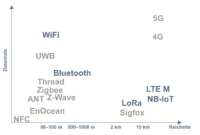
Was ist LoRa?
LoRa steht für Long Range und ist ein drahtloses Datenübertragungsverfahren bzw. eine Funktechnik.
Sie wurde ursprünglich von dem Halbleiterhersteller Semtech entwickelt und zeichnet sich durch eine hohe Reichweite und einen sparsamen Energieverbrauch aus. Auf freien Flächen kann die Reichweite bis zu ca. 10 km und innerstädtisch bis zu ca. 3 km betragen, abhängig von den Gegebenheiten und möglichen Hindernissen vor Ort. Zudem durchdringen die Signale auch Wände und reichen bis in Keller, Schächte und Brunnen. Damit eignet sich LoRa bestens für die Vernetzung weit verteilter Sensoren und Aktoren.
Frequenzbänder und Datenraten von LoRa
Für die Übertragung werden lizenzfreie Frequenzbereiche verwendet. In Europa ist dies beispielsweise das 868 Mhz Band. Der Vorteil ist, dass diese Frequenz im Gegensatz zu Mobilfunk unter Einhaltung bestimmter Bedingungen kostenfrei genutzt werden kann, d. h. keine Gebühren anfallen.
Bei der Auswahl der LoRaWAN-Geräte und Sensoren muss entsprechend darauf geachtet werden, ob das jeweilige Gerät bzw. der Sensor für den Standort ausgelegt ist.
| Standort | Frequenzband |
|---|---|
| Europa | 433,05–434,79 MHz; 863–870 MHz |
| Nordamerika | 902–928 MHz |
| Südamerika | 915 MHz |
| Pazifik | 434 MHz |
| China | 470–510 MHz; 779–787 MHz; 920,5–924,5 MHz |
| Indien | 865–867 MHz |
| Australien | 915–928 MHz |
| Japan | 920–923 MHz |
Um die öffentlichen Frequenzen aber nicht zu überlasten, dürfen die Datenpakete max. 243 Byte groß sein. Die Datenübertragungsrate liegt zwischen 300 Bit/s – 50 kBit/s und ist abhängig von der Entfernung zwischen Endgerät und Gateway. Je näher das Endgerät am Gateway liegt, desto höher die Datenrate, umso schneller die Datenübertragung und geringer der Energieverbrauch. Außerdem darf die zulässige „Time on Air“, d. h. die Gesamtdauer der Übertragung nicht überschritten werden. Demnach ist LoRa nicht für Echtzeitanwendungen geeignet, trägt aber dazu bei, dass die Batterie in den Sensoren länger hält, und eignet es sich für die unterschiedlichsten IoT-Anwendungen.
Was ist der Unterschied zwischen LoRa und LoRAWAN?
Während LoRa den Funkstandard bezeichnet, steht LoRaWAN für Long Range Wide Area Network (dt. Niedrigenergieweitverkehrnetzwerk) und gehört neben NB-IoT und LTE-M zu den zu LPWAN-Technologien. Es beschreibt das LoRa-Netzwerk sowie das gleichnamige offene Kommunikationsprotokoll. Dabei haben das Protokoll und die Netzwerkarchitektur den größten Einfluss auf die Batterielebensdauer eines Sensors, die Netzwerkkapazität, Servicequalität, Sicherheit und Vielfalt der vom Netzwerk bedienten Anwendungen.
LoRaWAN zielt auf die wichtigsten Anforderungen des IoT – Internet of Things (Internet der Dinge) ab wie sichere bidirektionale Kommunikation, Lokalisierung und Mobilität von Dienstleistungen. Zudem bietet es eine nahtlose Zusammenarbeit verschiedener Systeme und Techniken unter Smart Things ohne die Notwendigkeit von starren, lokalen komplexen Installationen. Ein weiterer Vorteil von LoRa liegt darin, dass die Anzahl der Endgeräte, die eingebunden werden können, nahezu unbegrenzt ist. Einmal aufgebaut, lässt sich ein LoRaWAN-Netzwerk jederzeit flexibel erweitern.
Vorangetrieben wird LoRaWAN durch die LoRa Alliance, einer gemeinnützigen Organisation zur Förderung und Standardisierung von Low-Power-Wide-Area-Network-Technologien. Sie wurde 2015 gegründet. Die mittlerweile mehr als 500 Mitglieder, darunter Technologieführer wie IBM, Cisco, HP, Foxconn, Semtech and Sagemcom, arbeiten eng zusammen und tauschen Erfahrungen aus, um den Erfolg des LoRaWAN®-Standards als führender offener globaler Standard für sichere IoT-LPWAN-Konnektivität zu fördern und voranzutreiben.
Anwendungen von LoRa und LoRaWAN
LoRa und LoRaWAN eignen sich für unterschiedlichste IoT-Anwendungen, bei denen eher kleinere Datenmengen über große Entfernungen, jedoch nicht echtzeitkritisch, übertragen werden sollen.
Bei typischen Anwendungen geht es oft um Ereignis gestütztes Melden und/oder „Suchen & Finden“. Messdatenerfassung & lokales „Asset Tracking“ sind große Themen im IoT, z. B. eine vernetzte Lieferkette, die sicher und zuverlässig funktioniert oder Behälter- bzw. Flächenmanagement, sowie Energie- und Wasserversorgung, Füllstandüberwachung von Silos, Containern und vielem mehr.
Gängige Beispiele von IoT-Anwendungen, bei denen LoRaWAN eingesetzt wird:
- Smart City: bedarfsgesteuerte Straßenbeleuchtung, Ampelsteuerung oder Verkehrsmessung zur Verkehrslenkung, Monitoring von Abfallbehältern zur Routenoptimierung für Entsorgungsfahrzeuge/Müllabfuhr, Parkplatzsteuerung über Parkplatz-Sensoren (Smart Parking)
- Smart Metering: Fernablesung von Strom-, Wasser- und Gaszählern, Austausch von Stromverbrauchsdaten mit einem Versorger/Stadtwerk
- Umweltmonitoring: z. B. Überwachung der Luftqualität, Pegelständen von Gewässern
- Logistik: Asset-Tracking, d.h. Einsatz von GPS-Trackern zur Verfolgung von Ladungen, Geräten oder Fahrzeugen, Behältermanagement/Stückgutverfolgung auf definierten Arealen
- Smart Farming: Überwachung von Tieren, Ställen und Feldern – von Bodenfeuchte Sensoren bis Temperatursenorik für Tier und Stall
- IIoT/Industrie 4.0: Condition Monitoring (dt. Zustandsüberwachung) von Maschinen und Anlagen, Optimierung von Produktionsabläufen
- Digital/Smart Health: z. B. Alarme, Tracking von Krankenhausbetten
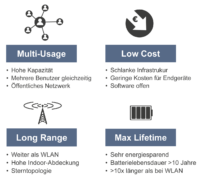
Vorteile von LoRaWAN
Einer der wichtigsten Vorteile von LoRaWAN ist die Wirtschaftlichkeit: Die Infrastruktur ist schlank, schnell implementiert und lässt sich gut skalieren. Die Architektur des IoT-Systems basiert generell auf vier Bestandteilen: Endgeräten mit LoRaWAN-Modul, Gateways für das Einsammeln und Weiterleiten der Daten, einer Daten-Cloud mit IoT-Plattform als Backend sowie Applikationen zur Visualisierung der Daten, Steuerung von Anwendungen etc.
Darüber hinaus fallen die Betreiberkosten sehr günstig aus, resultierend aus der kostenfreien Datenübertragung und der hohen Energieeffizienz der batteriebetriebenen Endgeräte. Strom wird nur in dem Moment verbraucht, wenn Sensoren beziehungsweise Aktoren zeit- oder ereignisgesteuert Daten mit dem Backend austauschen. Ansonsten „schlafen“ die Geräte. Im Aktivitätsmodus wird wiederum nur so viel elektrische Leistung für das Sendesignal in Anspruch genommen, wie für die Erreichbarkeit des nächsten Gateways maximal erforderlich ist. Durch diesen sparsamen Energieverbrauch werden Batterielaufzeiten von bis zu zehn Jahren und mehr erreicht. Das wirkt sich auch auf die Wartung positiv aus: Nur im Störfall, der bei ausbleibendem Datenaustausch unmittelbar zu erkennen ist, und beim Batteriewechsel – der Ladezustand wird im Backend angezeigt – muss ein Techniker vor Ort tätig werden.
LoRaWAN Sicherheit
Außerdem sind LoRaWAN-Netze sehr sicher, da bei LoRaWAN-Protokollen Ende-zu-Ende-Verschlüsselungsalgorithmen angewendet werden. Die Daten werden vom Sensor bis zur finalen Applikation verschlüsselt übertragen. Der Sicherheitsmechanismus basiert auf dem AES-Verschlüsselungsalgorithmus unter Verwendung einer IEEE-EUI64-Kennung. Ein korrekt implementiertes Verschlüsselungsverfahren wie zum Beispiel die 128 Bit AES-Verschlüsselung bietet ein hohes Maß an Sicherheit. Der zusätzliche Einsatz von HTTPS und VPN erhöht die Sicherheit noch.
Sie sehen gerade einen Platzhalterinhalt von YouTube. Um auf den eigentlichen Inhalt zuzugreifen, klicken Sie auf die Schaltfläche unten. Bitte beachten Sie, dass dabei Daten an Drittanbieter weitergegeben werden.
Mehr InformationenIm Podcast von IT & Tech erklärt Marius Nickolai, CEO von m2m Germany, ganz verständlich die Grundlagen zu LoRaWAN und gibt einen Überblick zu den Anwendungsmöglichkeiten.
Wie ist ein LoraWAN-Netzwerk aufgebaut?
Ein LoRaWAN-Netzwerk besteht mindestens aus folgenden Komponenten:
LoRaWAN-Sensoren (Nodes): Die Sensoren senden Messwerte in verschlüsselten Datenpaketen an das LoRaWAN-Gateway über den Funkstandard LoRa.
LoRaWAN-Gateway: Das Gateway empfängt Datenpakete und leitet sie mittels LoRaWAN-Protokoll an den LoRaWAN-Server weiter.
LoRaWAN-Server: Auf dem LoRaWAN-Server befindet sich das eigentliche Netzwerk, in dem die Daten gesammelt werden; der Server dient als Schnittstelle zu weiteren Diensten/Datenbanken, üblicherweise IoT-Plattformen und Applikationen.

Application Server: Um die Daten visualisieren und auswerten zu können, werden entsprechende Anwendungen benötigt. Dafür dient der Application Server oder ein anderer Dienst. An diesen werden die Daten vom LoRa-Server weitergeleitet, wo sie endgültig gespeichert werden.
In einem LoRaWAN sind die Netzkwerkknoten nicht einem bestimmten Gateway zugeordnet. Stattdessen werden Daten eines Knotens typischerweise von mehreren in der Nähe erreichbaren Gateways empfangen. Jedes Gateway leitet das empfangene Datenpaket an den Netzwerk-Server dann über WLAN, Mobilfunk, Ethernet oder Satellit weiter an den Application Server. Die Datenübertragung von den Sensoren bis zum Application Server erfolgt vollständig verschlüsselt, d. h. sie ist sehr sicher.

LoRaWAN-Produkte im m2m IoT-Shop
LoRaWAN-Sensoren
LoRaWAN-Sensoren für unterschiedlichste Anwendungen von Raumklima über Füllstände bis Wetterstation, einfach per Plug&Play.
LoRaWAN-Gateways
Im m2m IoT-Shop finden Sie industrietaugliche LoRaWAN-Gateways für den Indoor- und Outdoorbereich.
LoRaWAN-Antennen
Antennen sind die entscheidende Komponente für die Leistungsfähigkeit des LoRaWAN-Netzwerks und seiner Reichweite bzw. Durchdringung.
LoRaWAN Klassen
LoRaWAN-Endgeräte dienen verschiedensten Einsatzzwecken und unterscheiden sich in ihren Anforderungen. Dafür nutzt LoRaWAN verschiedene Geräteklassen. Alle Klassen erlauben eine bidirektionale Kommunikation, d. h. sie können Daten sowohl senden als auch empfangen.
Generell werden die Daten zwischen Endgerät, meist einem Sensor, und dem LoRaWAN-Gateway ausgetauscht. Dabei wird zwischen Uplink und Downlink unterschieden. Uplink bezeichnet das Senden der Daten vom Endgerät an das Gateway, wobei Downlink den Empfang der Daten vom Gateway an das Endgerät meint. Bei allen Klassen können jederzeit Daten an das Gateway gesendet werden. Jedoch ist das Downlink-Verhalten, also wie Daten vom Gateway empfangen werden können, je nach Klasse unterschiedlich.
Endgeräte der Klasse A
Auf dem Markt erhältliche LoRaWAN-Endgeräte müssen immer der Klasse A entsprechen und sind daher die am weitesten verbreiteten. Sie funktionieren nach dem ALOHA-Verfahren. Dies ist eine Kommunikationsmethode, bei der eine Quelle Daten in sogenannten Frames verschickt. Kommt ein Frame erfolgreich am Ziel an, wird der nächste Frame losgeschickt. Kommt es zu Kollisionen mit anderen Frames, wird der Frame erneut gesendet.
Bei Geräten der Klasse A sendet ein LoRaWAN-Sensor Datenpakete an das Gateway, anschließend öffnen sich zwei Downlink-Empfangsfenster. Während dieser Empfangsfenster kann der Sensor Daten empfangen. Außerhalb dieser Empfangsfenster können keine Daten empfangen werden. Das Gerät befindet sich in dieser Zeit in einem Schlafmodus, um die Batterie sparen. Ein erneuter Downlink kann nur bei einem erneuten Upload erfolgen.
Endgeräte der Klasse B
Endgeräte der Klasse B funktionieren wie Klasse-A-Geräte, jedoch gibt es zu den zwei definierten Empfangsfenstern weitere festgelegte Downlink-Fenster. Damit das Endgerät den Downlink zum geplanten Zeitpunkt empfangen kann und aus dem Schlafmodus „aufwacht“, empfängt es ein zeitlich synchronisiertes Beacon (also ein sehr kleines Datenpaket) vom Gateway. Dadurch weiß der Server, wann das Endgerät empfangsbereit ist.
Endgeräte der Klasse C
Endgeräte der Klasse C sind fast ununterbrochen empfangsbereit, verbrauchen dementsprechend auch mehr Energie als die Klassen A und B. Die Empfangsfenster werden nur bei der Upload-Übertragung geschlossen.
Wir sind LoRaWAN Full Service Provider
Sie wollen CO2 Werte messen, Umweltfaktoren monitoren? Ein smartes Energiemanagement und Metering umsetzen? Vielleicht planen Sie aber auch ein smartes Parkraum-Management oder eine intelligente Straßenbeleuchtung. Dann macht es Sinn, mit einem LoRaWAN Full Service Provider zusammen zu arbeiten. Die m2m Germany GmbH unterstützt und begleitet Sie während des kompletten Prozesses – vom Sensor über den LoRaWAN Network Server bis zur Anwendung. Von der Funknetzplanung bis zur Umsetzung Ihres speziellen Use Cases.
